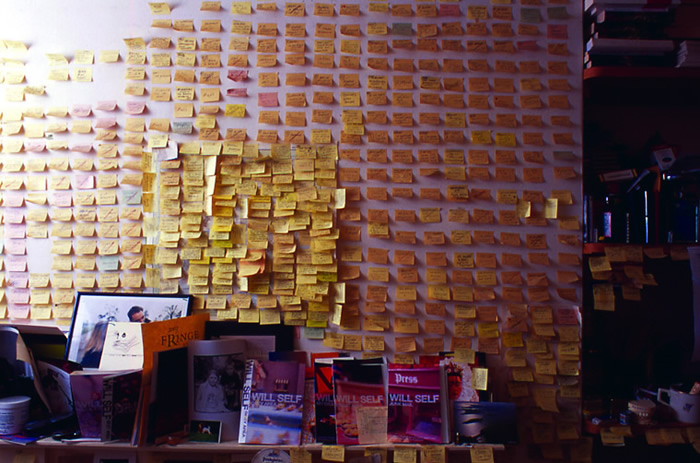Last time I was in Dublin, Vivian drove me round in a big black Merc; this time it’s a still bigger and blacker Chrysler. “I should’ve bought a cement truck,” he observes, as we ooze past the Point, a massive new shopping-cum-entertainment complex that’s sprouting a small forest of large cranes. “I’d be coining it now.” Last time I was in Dublin, the old city seemed teetering on the edge of being metropolitan – now it’s fallen over. Last time I was in Dublin, the joke was the group of three pyramidical office blocks on the bank of the Liffey that were known locally as “Canary Dwarf”; now it’s them that have been dwarfed – or, at any rate, flanked by acre upon acre of plate glass and steel.
The day I was in town, things looked to be going well for the egregious Bono, and his partner in development, the Edge. Their plans to have Norman Foster revamp their Clarence Hotel – also on the banks of Holy Liffey – were flowing through the planning board meeting, and despite some sour remarks from a local conservationist, Michael Smith, who described the proposed building as a “cannibalistic behemoth”, it looked as if they’d get the go-ahead.
I couldn’t get excited about the new hotel – but then, who can? Show me someone who’s excited about a new hotel, and I’ll show you a raving eejit with the soul of a shebeen-keeper. Vivian drove Cormac and I out to the Royal Hospital in Kilmainham, not, you appreciate, because we were old soldiers who needed taking care of, but because the historic building (complete in 1684, two years before the Royal Hospital in Chelsea), is now home to the Irish Museum of Modern Art. We were going to see an exhibition of William Burroughs’ shotgun painting, bizarrely juxtaposed with examples of Hans Christian Andersen’s beau coupage. Hmm.
The paintings were shite, basically, any old junkie with a shotgun could’ve pulled it off, but more importantly there was one of Burroughs and Brion Gysin’s original “dream-catching” machines. The whirligigs of light and motion that the two writers believed put them in touch with the noumenal world. I’m already hot-wired to this, but Peter – who we’d picked up en route – was a tad dismissive: “It’s basically a Lava Lamp,” he said, but I came back at him, “What’s wrong with Lava Lamps? I love Lava Lamps; in fact, I love Lava Lamps more than I love people.” Incidentally, the Andersen cut-outs were quite pretty.
In the bowels of the ancient building, where James Connolly was held for a time after the Easter Rising until the Brits got round to executing him, we chanced upon a potent symbol of Ireland, old and new: a photo-real image of a man’s hands cradling a rugby ball made from the hide of a living cow, complete with several teats. “It makes me feel queasy just looking at it,” Cormac said, but I caught the hint of desire in his tone.
Last time I was in Dublin, the European Union heads of state were there; this time it was José Manuel Barroso, President of the European Commission. Barroso was intent on selling the benefits of a new World Trade Agreement, but the Irish farming community weren’t so sure; they’d come up from the sticks in force, and as Cormac and I reached Heuston Station there they were, florid-faced men in tweed, their fingers itching to grab the teats on a living rugby ball.
This was to be the highpoint of my visit: last time I was in Dublin, the traffic was all snarled up because they were building the track for the new light railway, the Luas, but now it was done and we were to take a ride. “It wasn’t open two days,” Cormac said, “and they were calling it the Daniel Day.” The Daniel Day hove into view, all shiny and new, but still, unmistakably … “Look, Cormac,” I told him, “I don’t know how to break this to you, but that’s a tram.”
We rode the tram into Jervis, by the Four Courts, and then crossed the James Joyce Bridge to the other side of the Liffey. At least, I think it was the James Joyce Bridge; it could’ve been the Samuel Beckett Bridge, or the Jonathan Swift Bridge, or the Flann O’Brien Bridge. At the rate they’re going with these writerly Dublin bridges, they’ll have one for old Maeve Binchy ‘n’ all. Still, if they know how to honour their writers in Ireland, they also know how to honour their painters. After all, Francis Bacon’s London studio was painstakingly dismantled, crated, shipped, and then reassembled in a Dublin art gallery.
It’s the same with smoking. That night we dined in a small bistro where an outside area had been equally painstakingly contrived to look like a room, complete with walls, carpeted floor, and an almost ceiling. Space heaters kept us warm as we puffed, supped and munched. Last time I’d been in Dublin, it had been … exactly the same. Pure genius, indeed.
03.05.08
To see Ralph Steadman’s accompanying artwork, visit here
